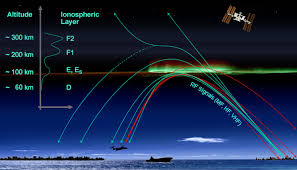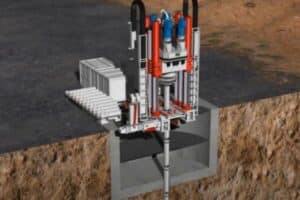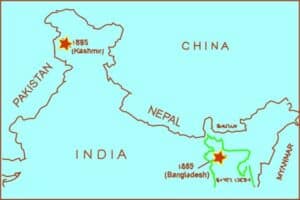
Assignment on Ionosphere
Electricity and magnetism of ionosphere: The ionosphere is the ionized part of earths upper atmosphere from about 48 km to 965 km altitude. A region that includes the thermosphere and part of the mesosphere and exosphere . The ionosphere is ionized by solar radiation. It plays an important role in atmosphere electricity and forms the inner edge of the magnetosphere to distant places of the earth.
Geophysics – the physics of the earth and its environment in space also the study of the earth using quantitative physical methods. Modern geophysics involves broader definition that includes hydrological cycle, snow and ice fluids dynamics of the ocean, electricity and magnetism in the ionosphere and magnetosphere .
The ionosphere is a shell of electrons and electrically charged atoms and molecules the surrounds the earth , stretching from a height of about 50 km to more than 1000 km . It exists primarily due to ultraviolet and X-ray and shorter wavelength of solar radiation are ionizing since photons at these frequencies contain sufficient energy to dislodge an electron from a neutral gas atom or molecule upon absorption.
The reverse process of ionization is recombination . Ionization depends primarily on the sun and its activity . The local winter hemisphere is tipped away rom the sun , thus there is less received solar radiation.
Various layer present in the ionization OF IONOSPHERE
These are termed as E, D, F.
At night F layer is the only layer of significant ionisation present , while the ionisation in the E an D layer is extremely low . During the day , the D and E layers become much more heavily ionized as does the F layer , which develop an additional weaker region of ionisation known as the F1 layer. The assignment of the ionosphere is the ionized part of earths upper atmosphere from about 48 km to 965 km altitude.
The ionosphere is important because it influences radio propagation to distant places on Earth. It also affects GPS signals that travel through this layer. The layers of the ionosphere vary in thickness depending on the time of day and year. During the day, solar radiation is strongest, and the ionosphere is thickest. At night, the ionosphere thins as solar radiation weakens.
There are three main regions in the ionosphere, each with different characteristics:
- The D region (50 to 90 kilometers or 31 to 56 miles) is the lowest layer. It absorbs some radio waves, especially at lower frequencies.
- The E region (90 to 150 kilometers or 56 to 93 miles) is the middle layer. It reflects radio waves in the medium-frequency (MF) and low-frequency (LF) ranges. This allows radio waves to travel over long distances by reflecting off the ionosphere and back down to Earth.
- The F region (above 150 kilometers or 93 miles) is the topmost layer. It is the most variable layer and can split into two layers, the F1 and F2 layers, during the day. The F region reflects radio waves in the high-frequency (HF) range. HF radio waves can travel around the world by reflecting off the ionosphere.
The ionosphere plays a vital role in several ways that benefit us here on Earth. Here’s a breakdown of its key contributions:
1. Long-distance Radio Communication:
- The ionosphere acts like a giant mirror in the sky, particularly for radio waves in the medium-frequency (MF) and high-frequency (HF) ranges. These waves can travel long distances by bouncing off the ionosphere and back down to Earth. This phenomenon allows for:
- Shortwave radio communication: Enables communication over vast distances, essential for ships and airplanes beyond the range of line-of-sight radio signals.
- International broadcasting: Makes it possible to transmit radio signals across continents, facilitating the spread of information and entertainment.
- Amateur radio communication: Enables hobbyists and radio enthusiasts to communicate over long distances.
2. GPS Signal Functioning:
- The ionosphere can affect the accuracy of GPS signals. GPS signals travel from satellites in orbit to receivers on Earth. These signals can be slightly delayed or refracted as they pass through the ionosphere. However, advanced GPS systems account for this effect and can still provide accurate positioning data.
3. Protection from Harmful Solar Radiation:
- The ionosphere absorbs some of the extreme ultraviolet (EUV) radiation from the Sun. This radiation can be harmful to living organisms. While the atmosphere plays a major role in shielding us, the ionosphere provides an additional layer of protection.
4. Auroras (The Northern and Southern Lights):
- Collisions between charged particles from the Sun (solar wind) and atoms and molecules in the upper atmosphere, including the ionosphere, create beautiful auroras (also known as the Northern Lights or Southern Lights). These colorful displays are a natural phenomenon and a captivating aspect of our night sky.
5. Research and Understanding of Space Weather:
- By studying the ionosphere, scientists can better understand the effects of solar activity on Earth’s atmosphere. This knowledge helps us predict and mitigate potential disruptions caused by space weather events, such as interference with communication signals or power grids.
What We Know (or Think We Know) About the Early Earth’s Ionosphere:
- Less Ionized: The early Earth’s atmosphere likely had a weaker or less ionized ionosphere compared to today. This is because the Sun was younger and less energetic, emitting less solar radiation which is the main driver of ionization.
- Composition Differences: The early atmosphere is thought to have contained less oxygen and more carbon dioxide and methane. This different composition would have influenced the types of ions present in the early ionosphere.
- Impact on Early Life: The weaker ionosphere might have allowed more harmful solar radiation to reach the Earth’s surface, potentially impacting the development of early life forms. However, the presence of other protective factors like oceans and volcanic activity also needs to be considered.




